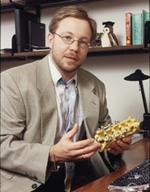I’ve held off blogging about a recent piece at EnGadget involving Rice because, frankly, I didn’t understand what they were getting at.
Turns out they were getting at something very important indeed, namely something I’ve called The World of Always On since 2003.
Specifically, computer engineering professor Lin Zhong and bioengineering professor Michael A. K. Liebschner (left) were looking for a more reliable way to move signals between medical sensors and actuators placed in or on the body.
The idea is that a sensor picks up a condition requiring action, a processor chip defines the proper action to take, and some actuator takes the action, all without an intervening human control. When we’re talking about, say, a heart patient, this is life-and-death stuff.
Electricity is the communications system used by the human body, passing signals through nerves to the brain, then on to muscles and tendons. But that’s being used. Radio is the system used by computers to move data between always-on devices, but given that people live inside a radio-wave filled biosphere that’s not always reliable.
The answer was sound. The Rice scientists applied vibrators to the body, and found that a frequency shift key (FSK) signal, a simple change in a tone’s pitch, run through the skeleton could be easily registered as a command. "This is quite amazing because all the links involved multiple bones and many joints," said Zhong. "All data transfer is contained inside the human body, and it can only be retrieved through direct physical contact," added Liebschner.
As a practical measure, this would allow a vibrator on your wrist to
activate the administration of a drug — insulin or sugar water to a diabetes
patient (or one going through hypoglycemic shock). In less stressful
circumstances, it might let you activate a phone by clacking your
teeth.
Naturally the latter sort of thing is what the bloggers at EnGadget focused on, and the report was quickly picked up by GadgetScoop, Jaiku
and elsewhere. Lost was some important science — a third modality for
moving data among always-on medical devices. Not to mention the really
vital kicker, a reliable way to save the life of someone from EnGadget,
GadgetScoop and Jaiku when they have a condition requiring monitoring.











